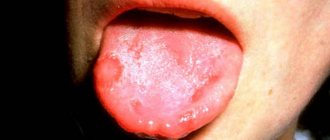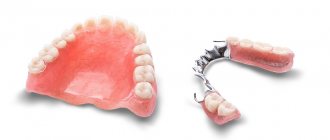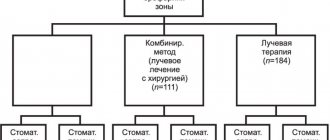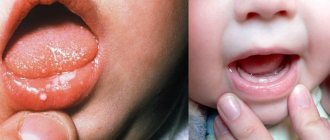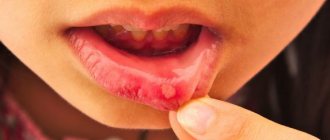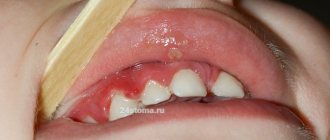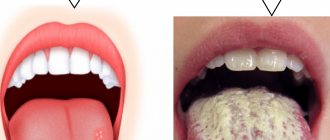Stomatitis is a group of inflammatory processes of various origins that affect the oral mucosa. The main symptoms of stomatitis are the appearance of areas of redness and swelling of the mucous membrane, as well as blisters and erosions. These signs are accompanied by pain and burning while eating. The specification of the clinical picture depends on the type of stomatitis. The cause is determined after taking a smear from the affected area. Treatment is complex and includes symptomatic, early cleansing and antiulcer therapy. In mild forms of pathology, recovery is sufficient to maintain hygiene and sanitize the affected areas. Frequent relapses and a complicated course indicate the presence of a systemic pathology, the symptom of which is stomatitis.
Causes of stomatitis in adults
According to the etiology, stomatitis in adults occurs:
- traumatic;
- aphthous;
- catarrhal;
- ulcerative;
- candida;
- vesicular;
- bacterial (staphylococcal, streptococcal);
- angular;
- allergic.
Traumatic stomatitis develops as a result of injuries to the oral cavity caused by dentures, chips on tooth enamel, and food. After eliminating the traumatic element, the mucous membrane restores itself. Another reason for this type of pathology is the choice of hot or spicy foods. The result of such eating habits is a burn of the mucous surfaces of the mouth. Its development is provoked by:
- carious cavities with a sharp edge;
- fragments of teeth;
- burns;
- poorly installed crowns, dentures, braces;
- bad habit of biting lips, cheeks, tongue;
- malocclusion, pathological shape of teeth;
- addiction to excessively hot, cold or spicy foods;
- smoking;
- frequent consumption of foods that injure the mucous membrane (nuts, seeds).
The causes of the chronic form of aphthous stomatitis are not fully established. Presumably, the pathology is caused by staphylococci, adenoviruses, autoimmune reactions, and immune disorders.
Specific signs of aphthous stomatitis:
- the oral cavity is strewn with aphthae: round or oval ulcers;
- the center of the ulcer is covered with a gray or yellow coating, the edges are outlined by a narrow area of hyperemia.
Clinical picture of catarrhal stomatitis:
- swelling, hyperemia and painful discomfort of the oral mucosa;
- increased salivation;
- yellowish-white plaques of plaque on the mucous membrane;
- less often - slightly bleeding erosions, foul-smelling breath.
Ulcerative stomatitis occurs as a result of severe catarrhal stomatitis or independently. Sometimes considered a complication of catarrhal disease.
Candidal stomatitis (“thrush”) is a mycotic pathology caused by the hyperactivity of fungi of the genus Candida. Factors conducive to development include:
- immaturity of immunity in infancy;
- deterioration of the body's protective functions due to hematopoietic pathologies, infections, cancer, AIDS;
- old age (there is a natural decline of immune forces);
- hormonal changes during pregnancy;
- neglect of the rules of oral hygiene;
- use of dental prosthetic structures;
- drying out of the mucous membrane;
- pathologies of glucose absorption;
- taking glucocorticoid sprays;
- long-term antibiotic therapy.
Vesicular stomatitis develops as a result of contact with viruses of the genus Vesiculorus, which parasitize the body of cattle. Contamination occurs through the process of mosquito bites. Most often, this type of stomatitis affects veterinarians and farm workers.
Bacterial stomatitis occurs with a pathological increase in the population of bacteria of opportunistic microflora, usually against the background of weakened immunity.
Activation of staphylococcal and streptococcal stomatitis occurs against the background of:
- carious inflammations;
- oral injuries;
- purulent processes in periodontal pockets;
- reduction of local immunity of the oral cavity;
- non-compliance with antiseptic and aseptic rules during surgical and dental treatment.
A type of bacterial stomatitis is angular stomatitis. The cause of the pathology is not only streptococci, but also yeast-like fungi that are part of the symbiotic microflora of the human body.
Allergic stomatitis is a type of pathological autoimmune reaction. Clinical manifestations are polymorphic and include a group of dermatostomatitis, multimorphic exudative erythema and stomatitis of various etiologies (usually catarrhal or aphthous).
Types of angular stomatitis
The symptoms of the disease are largely determined by the form of the bacterial infection, which allows us to distinguish two main types of the disease:
- Streptococcal angular stomatitis. It is more common in children, develops due to a streptococcal infection entering the body and appears quite suddenly. One or more bubbles form near the oral cavity, in which clear liquid accumulates. At a certain point, they open, and erosions appear in these places, which cause pain, itching and burning.
- Candidal angular stomatitis. It is caused by exposure to yeast-like pathogenic microflora. This type of disease is, as a rule, sluggish in development, and bubbles do not form in this case. There is red erosion surrounded by a whitish fringe. Next, a white cheesy coating forms on the affected area - it can be safely removed, but after a few hours it appears again. This is a waste product of fungi. Candidal angular stomatitis develops with reduced immunity, which can be facilitated by frequent stressful situations, hypothermia or a common cold.
Types of disease
Based on the nature of the inflammatory elements formed on the mucosa, the following classification is accepted in dentistry:
- Aphthous stomatitis. Areas of inflammation look like oval and round ulcers - aphthae. This clinical form of pathology is divided into types:
- Necrotizing stomatitis. It occurs against the background of severe systemic pathologies. Characterized by the death of cells on the mucous surface in the mouth. Foci of inflammation are painful, on the 3rd-5th day of development of the pathological process they grow, and ulcers appear in their place. Aphthae heal within a month.
- Fibrinous stomatitis. The surface of aphthous ulcers is covered with a gray coating. From the moment of ulceration until the integrity of the mucous membrane is restored, 7-21 days pass. According to statistics, once every 1-3 years there is a relapse of fibrinous stomatitis.
- Scarring. Severe form of stomatitis. It begins with the formation of aphthous inflammations, growing day by day. Soon deep ulcers up to one and a half centimeters in diameter form in their place. Healing takes up to 12 weeks, and scars remain at the site of the ulcers.
- Glandular stomatitis. It affects the salivary glands, which are located throughout the oral cavity. Aphthae form at the exit of the salivary ducts. Painful when pressed.
- Deforming. The most severe variant of the pathology in its manifestations. Ulcers affect large areas of the mucous membrane and heal poorly. After the inflammatory stage, the ulcers heal with the formation of scars and scars that tighten the tissue, causing the oral cavity to become deformed.
- Catarrhal stomatitis is a process of pathology of the upper layers of the oral mucosa. Accompanied by bad breath, swelling and hyperemia of inflammation. The affected mucosal fragments are covered with plaques with a white coating, and tooth imprints remain on the gums and soft tissues of the tongue. There are severe pain, increased salivation, a slight increase in body temperature and weakness.
- Ulcerative gangrenous stomatitis. Severe form: the mucosa is affected by areas of ulceration and necrosis. The inflammatory process can destroy the entire thickness of soft tissue, down to the bone. Accompanied by severe weakness.
Types of stomatitis
There are many types of oral stomatitis.
Catarrhal stomatitis
The most common type of stomatitis. With this unpleasant disease, the oral mucosa becomes swollen, painful, hyperemic, and may be covered with a white or yellow coating. There is an increased secretion of saliva. All this may be accompanied by bleeding gums and bad breath. The causes are local factors: poor hygiene, caries, tartar, oral candidiasis. Catarrhal stomatitis also occurs as a result of diseases of the gastrointestinal tract and worms.
Ulcerative stomatitis
A more severe disease than catarrhal disease. It can develop independently or be an advanced form of catarrhal stomatitis. Most often it develops in people suffering from gastric ulcers or chronic enteritis, diseases of the cardiovascular system and blood, infections and poisoning. With ulcerative stomatitis, the entire thickness of the mucous membrane is affected, there is an increase in temperature to 37.5 0C, weakness, headache, enlargement and tenderness of the lymph nodes. Eating is accompanied by severe pain.
Aphthous stomatitis
Causes of the disease: gastrointestinal tract, allergic reactions, viral infections, rheumatism, and heredity. Aphthous stomatitis has symptoms:
- the appearance on the oral mucosa of single or multiple aphthae - small ulcers (3 - 5 millimeters) of gray-white color with a narrow red rim;
- bad feeling;
- increased temperature and pain of ulcerative lesions.
The disease can have an acute form or occur chronically with periods of exacerbation and remission, the so-called chronic recurrent aphthous stomatitis.
Candidal stomatitis
It is a fungal disease that most often appears in young children (stomatitis in children) and the elderly. This type of stomatitis is caused by a fungus (usually the Candida genus) and develops mainly when the body’s immune forces decrease, as a result of long-term treatment with strong antibacterial drugs, as well as against the background of another chronic disease. Candidal stomatitis has the following symptoms:
- burning sensation in the mouth and larynx,
- white coating on the tongue and mouth,
- hyperemia and bleeding of the mucous membrane,
- bad taste in the mouth or loss of taste.
This type of stomatitis is considered contagious and can be transmitted both through household and sexual contact.
Herpetic or herpes stomatitis
Occurs in both adults and children. It is caused by the herpes simplex virus and can be acute or chronic. Symptoms of herpetic stomatitis:
- in mild cases, small blisters appear, resembling aphthae;
- the severe form is characterized by multiple rashes on the mucous membrane;
- swelling and inflammation of the lining of the oral cavity;
- increased salivation;
- general malaise;
- toxicosis;
- elevated temperature;
- enlarged lymph nodes;
- burning sensation and pain when eating.
The peculiarity of herpetic stomatitis is that the herpes virus remains in the body forever.
Allergic stomatitis also occurs; read more about the disease in the article.
Allergic stomatitis
It is an allergic disease that can occur in both adults and children. Its etiology is different: if in childhood the allergen is most often food products introduced into the child’s diet for the first time, then in adult patients the triggering mechanism for the pathological reaction may be weakening of the immune system due to the use of certain medications, rejection of dentures or advanced inflammatory processes in the oral cavity.
The characteristic signs of allergic stomatitis are:
- itching in the mouth, increasing after eating;
- severe swelling of the oral mucosa;
- secretion of a large amount of thick saliva;
- hyperthermia;
- unbearable pain;
- bad breath.
For the treatment of allergic stomatitis, in addition to visiting a dentist, consultation with an immunologist and an infectious disease specialist is recommended.
Symptoms of stomatitis in adults
Aphthous stomatitis. At the beginning, signs of general intoxication of the body and malaise, hyperthermia, soreness of the mucous membrane, which soon becomes covered with aphthous ulcers, are recorded. During the healing process, canker sores become scarred and leave scars.
Herpetic stomatitis. When the oral cavity is infected with herpetic virus type 1-2, there is a high risk of developing acute herpetic stomatitis. Typically, the rapid beginning of the formation of the clinical picture: hyperthermia, pronounced signs of general intoxication of the body. During examination of the oral cavity, hyperemic, edematous mucosa with areas of bleeding gums is visible. Increased saliva secretion and bad breath may occur. A few days after the manifestation of the pathology, the mucous membrane becomes abundantly covered with small pustules and vesicles, and necrotic changes in the epithelium occur.
Catarrhal and ulcerative stomatitis. The symptom complex of these two types of pathology is similar at the beginning of the disease, but after a few days the ulcerative form is identified by specific signs: severe hyperthermia, fatigue, headache and swelling of the lymph nodes closest to the source of inflammation. Ulcerative stomatitis affects the area of ulcer formation throughout the entire depth of the tissue, catarrhal lesions are limited to the upper layer of the mucous membrane. The pain intensifies while eating, sometimes so severe that it forces you to refuse food. Symptoms develop progressively and are most noticeable in people with weakened immune systems.
Necrotizing ulcerative stomatitis, or Vincent's stomatitis, occurs as a result of the activity of symbiotic microorganisms: spindle-shaped bacteria and a type of spirochete. The main reason for the pathological activity of these microorganisms is weakened immunity. Clinical manifestations of necrotizing ulcerative stomatitis:
- scattering of ulcers and erosions in the mouth;
- low-grade fever;
- pain and bleeding when pressing on the gums;
- bad breath with a hint of rot;
- the pathological process begins from the gingival margin and spreads further.
Angular stomatitis is widely known as “jams”. This form of stomatitis is characterized by painful cracks in the corners of the mouth. A feature of angular stomatitis is that in other forms of the disease the inner surface of the oral mucosa is affected, and when jammed, the integrity of the outer mucous layer is disrupted. In addition to the seasonal decrease in immunity, among the provoking factors recorded:
- gastrointestinal diseases
- metabolic pathologies
- disturbances in the functioning of the endocrine system
- oral health problems
- long-term use of artificial hormones
- pathological growth of the streptococcus population;
- unbalanced diet;
- smoking and alcoholism;
- incorrect bite.
These factors create conditions for permanent irritation of the mucous membrane, which makes it vulnerable to erosion, attachment and the development of infections.
Allergic stomatitis, with all the polymorphism of manifestations, begins with dryness of the mucous membrane, itching sensations in the mouth and along the inner edge of the lips, the process of eating causes discomfort. The oral mucosa swells, becomes hyperemic, and in the absence of timely treatment, atrophy of the lingual papillae occurs.
Symptoms of stomatitis
Light redness of the oral mucosa is the first symptom of stomatitis. Over time, they swell and a burning sensation appears. If treatment is not started at this stage, the redness is replaced by small oval or round ulcers, grayish or white, with a red halo and a film on top. Moreover, the tissue around them looks absolutely healthy. Mouth ulcers are very painful and make eating difficult. They appear on the inner surface of the cheeks and lips, under the tongue. In most cases, mild stomatitis manifests itself as one ulcer.
The appearance of several ulcers of larger size and depth, which sometimes merge into one, are signs of more severe forms of stomatitis. The appearance of ulcers is accompanied by fever, inflammation of the lymph nodes, general deterioration of health, headache, loss of appetite and constipation. Acute stomatitis is accompanied by severe pain in the mouth, which interferes with eating and speaking. In addition, there may be excessive salivation, a coating on the tongue, a bright red mouth, irritability, and vomiting after eating.
Treatment of stomatitis in adults
It is important to start etiotropic treatment in a timely manner to prevent chronicization of the pathology. Therapy for stomatitis includes a set of measures:
- the symptomatic part of therapy consists of taking antipyretic drugs;
- in case of severe pain, painkillers are prescribed;
- the key stage of treatment is to find and eliminate the root cause of stomatitis: the causative agent or the underlying disease; which helps prevent relapses of the painful condition;
- local treatment involves the use of local agents with a healing and antibacterial effect;
- An important component of the treatment plan is the selection of a diet and the exclusion of products containing aggressive and irritating substances (menthol, sodium lauryl sulfate) from the regimen of regular hygienic treatment of the oral cavity.
A gentle diet includes adding soft fermented milk products, neutral vegetables and fruits, cereal porridges, lean boiled meat and low-fat broths to the diet. Tea and coffee should be avoided; it is recommended to replace them with decoctions, fruit drinks and water. Spicy, sour, hot dishes or food, parts of which can physically injure tissues affected by stomatitis, are excluded. After eating, you should rinse your mouth with water or a medicinal solution.
In cases of recontamination of ulcerated areas of the mucosa, drugs containing chlorhexidine bigluconate are used. Long-term use of these drugs has an unpleasant side effect: dark spots appear on tooth enamel and fillings, which disappear after the end of treatment.
Questions and answers
— Which doctor treats stomatitis in adults?
— The dentist deals with the treatment and prevention of stomatitis. He is also competent to diagnose the type of pathology and select an adequate therapeutic regimen. Since stomatitis in adults often acts as a symptom, consultation with another specialist is possible: a gastroenterologist, an infectious disease specialist, an endocrinologist, an allergist.
— How long does stomatitis last?
— Depending on the type and severity of stomatitis, the inflammatory process should subside within 7-10 days, and two weeks after the onset of the disease, complete recovery occurs. If alarming symptoms do not go away within the specified period, you need to contact your dentist again to find out the reasons or adjust treatment measures.
— What medicine helps with stomatitis?
— Unfortunately, a universal remedy for stomatitis is still unknown to science. Stomatitis is a group of pathologies, the causes of origin and manifestations are diverse. The development of pathology is influenced by factors such as the decline of the body’s immune forces, concomitant systemic diseases, and stress. The decision to prescribe a particular drug is made individually, depending on the clinical picture and characteristics of the body. When two different people have the same diagnosis, therapeutic measures differ.
Sources
The following materials were used in preparing the article:
- Anisimova I.V., Nedoseko V.B., Lomiashvili L.M. Clinic, diagnosis and treatment of diseases of the mucous membrane of the mouth and lips. - M.: 2008. - 194 p.
- Borovsky E.V., Mashkilleyson A.L. Atlas of diseases of the mucous membrane of the oral cavity and lips // Medicine - M.: 2001. - 703 p.
- Langle R. P., Miller K. S. Atlas of oral diseases: Atlas / Translation from English, ed. L. A. Dmitrieva. - M.: GEOTAR-Media, 2008. - 224 p.
- Danilenko S. M. The most common diseases of the oral mucosa // Consilium-Provisorium. - 2001. No. 6. - With. 6.

